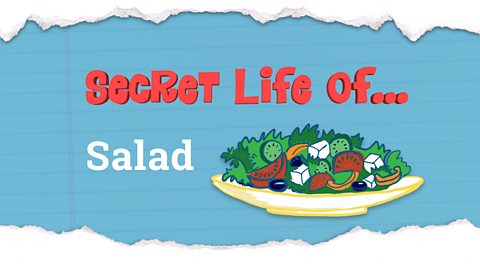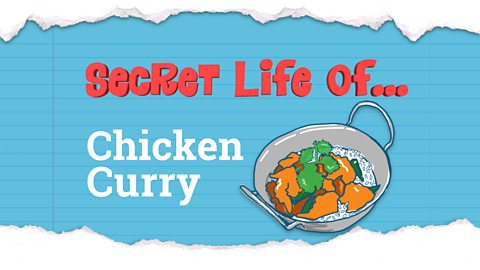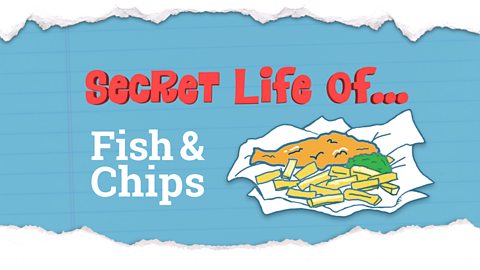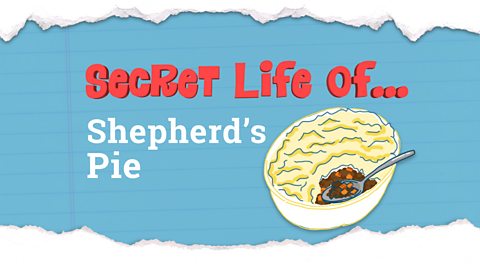GIRL: Spaghetti bolognese!
ITALIAN ACCENT: Spaghetti bolognese!
STEFAN GATES: It sounds very Italian doesn't it? And in some ways it is related to a dish they eat in Bologna in northern Italy hence the Bolognese bit. But bizarrely loads of the ingredients in it were actually imported from the rest of the world in the first place. It all starts with beef mince from cows. Now cows were first tamed in either Africa or Asia about 10000 years ago. But the question is where does our beef come from today? To answer that question we sent Gareth Barlow to a farm in Yorkshire. He knows a thing or two about farming and was even a butcher.
Historically a cow would have a life producing milk and once that that had finished farmers would use them for meat. But these days in modern farming different breeds are used for different things and some cows solely for milk. And then cows like this just for beef will one day end up as your burgers or your Sunday roast. So there are cows that produce milk and cows we farm for their meat known as beef. But how do you spot the difference? If you see cows grazing outside in the fields they're more than likely going to be used to produce milk as grass makes fantastic quality milk whereas beef cows like these are housed inside because it's easier to feed and look after them.
Lots of meat ends up being sold at a butcher's but you don't just buy any old bit of cow. You need to know what you are cooking to get the right piece of beef. Cows are such large animals they provide loads of meat. Great quality pieces like this roasting joint and steaks through to lesser quality like this shin beef which is put into larger machines than this and provides mince for things likeburgers and spaghetti Bolognese.
Now the best Bolognese takes a long time to develop all these lovely savoury flavours but to start off with you've got to brown the mince. And you've got to brown it in a pan that's really hot so that it fries rather than boils and that's really important because only when you get the really strong browning reactions do you develop these enormous savoury flavours that make the sauce so delicious. As soon as it's browned you put the mince on one side - fry it for too long it'll start getting all hard and chewy.
Now the reason this dish is so popular is that it is the perfect storm of tastes assaulting our senses. It's not just fluffy stuff this is real.
First of all you've got the tomatoes and you get a huge amount of sweetness from the tomatoes a little bit from the carrots as well but also a little bit of sourness from these. I'll add another bit of sourness with a bit of red wine vinegar and that's going to taste really good but then you get this amazing savoury sensation from this brown beef which gives it that kind of deep deliciousness that we really love. But if there's a magical ingredient in this it's this fella.
This is Parmesan cheese.
Now it might just seem like a nice bit of cheesiness to you but this is packed full of a chemical called glutamate. When you scatter this on your food at the end it's like scattering a bit of magic over it a huge hit of that savoury tastefulness and also a little bit of saltiness. The only one of the five primary tasters that's not in here is bitterness which makes this almost the perfect combination of tastes.
That's everything in my Bolognese sauce including putting the beef back in.
So you could eat it after 15 minutes of simmering but I want all those flavours to get to know each other so I'm going to leave it for a bit longer maybe a couple of hours. Long enough for me to make some pasta. The main ingredient in pasta is wheat. Wheat is the crop that gave rise to some of our first farmers over 6000 years ago. Most of our wheat today is winter wheat planted in the autumn and harvested in the summer. The important bit is up at the top of the plant. This is ground up and then milled again to make a fine flour. That flower is mixed with egg and kneaded and then kneaded some more and kneaded some more. Once it's all combined into a smooth dough it's into the fridge for 30 minutes for it to cool down. Now the fun really begins. You can use a rolling pin but I've got a pasta machine. The dough goes through the machine again and again and as it does so it gets thinner and thinner and longer and longer. A quick change to my magic machine and here comes the spaghetti.
ITALIAN ACCENT: Oh beautiful!
Now it needs to dry a bit before it's boiled in water so I liked to leave mine hanging around.
It's fantastic fun.
Here we go a little bit of our beautiful sauce on there. Scrape over the magic. Mm-mm! Little sprig of basil to make it look pretty. There we go.
So the big question is is it British? Is it Italian?
The answer is "No get yourhands off it's all mine!"
"Oh yeah."
Images, practical cooking demonstration and commentary explains where each ingredients for a traditional spaghetti Bolognese comes from.
It explores the northern Italian roots of the dish.
It shows how the dish can be made with fresh beef mince and homemade pasta dough extruded using a pasta machine.
It shows how wheat is grown, which part of the wheat plant is used to extract the grain, thus how a crop of wheat is made into flour then pasta.
A farmer in Yorkshire explains about how modern framing uses different breeds of cow for different things, so that we have cows for meat (beef mince for the Bolognese) and for milk.
It explains the importance of browning the meat for flavour and how the flavours develop during simmering.
It explains the role of the additional ingredients such as tomatoes and carrots (for sweetness/sourness) and parmesan cheese (Savoury and saltiness), as well as herbs (basil) to create a dish of balanced flavours.
This clip is from the series The Secret Life of Our Favourite Dishes.
Teacher Notes
Pupils could make the dish shown.
You could opt to focus on the sauce and use dried pasta, or you could make homemade pasta and serve with a simple tomato sauce (ragu).
They could taste some prepared pasta dishes (lasagne, pasta bake), deciding who they would be suitable for, when they would be eaten, what ingredients have been used and why, and exploring how they have been made.
Pupils could design a pasta dish for a particular occasion or person’s needs, for example, a picnic or school lunch. or for someone who is vegetarian or wheat intolerant.
This clip will be relevant for teaching Design and Technology and/or Food Technology at KS2 and KS3 in England and Wales, and 2nd and 3rd level in Scotland.
The story behind a salad. video
Practical cooking demonstrations and commentary, explains where the common ingredients for salads come from.

The story behind chicken curry. video
Images, practical cooking demonstration and commentary, explains where each of the component ingredients for a traditional chicken curry comes from.

The story behind fish and chips. video
Images, practical cooking demonstration and commentary explains where each ingredients for a traditional fish and chip meal comes from.

The story behind shepherd’s pie. video
Images, practical cooking demonstration and commentary, explains where each of the component ingredients for a traditional Shepherd’s Pie comes from.
